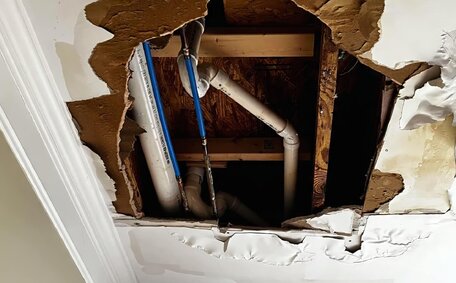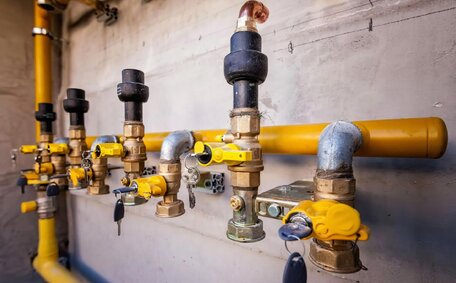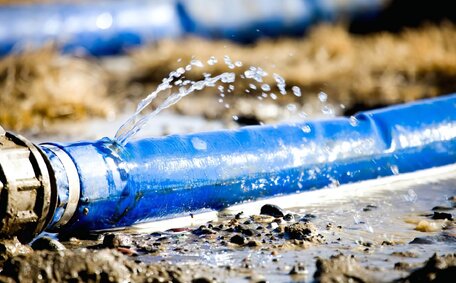Essential Hand Tools for Gas Fitters
Plumbing gas professionals rely on an array of specialised hand tools to safely and effectively carry out gas installation, repair, and maintenance tasks. Here is an essential plumbing tools list to ensure your gas fittings are installed competently:
- Pipe wrenches - For handling and adjusting pipes and fittings during assembly or dismantling of gas systems, prioritising durable and dependable tools.
- Tubing cutters - Enable accurate, neat cuts in copper, steel, and corrugated stainless tubing in gas lines, with ratcheting or roll wheel options for user comfort.
- Flaring tools - Essential for flaring metal tubing ends to fit with flare connections, requiring flaring tools with calibrated depth gauges for uniform results.
- Pipe threaders - Craft precise screw threads on gas pipes for fitting connections. Choose pipe threaders from reputable brands for reliable performance.
- Basin wrenches - Designed to grasp curved pipes behind sinks and basins in otherwise inaccessible areas.
- Gas leak detectors - Essential safety device to test for gas leaks using sensors. Look for durable, reliable models from Jomar or UView.
- Pipe benders - Let gas fitters manipulate small diameter copper tubing for gas lines, usually linking them to welding hoses.
- Bolt cutters - Effortlessly slice through nuts, bolts, or small metal pipes in restricted spaces.
- Hammers - Invaluable for general gas fitting tasks, choose durable claw hammers.
- Measuring tapes - Crucial for precisely measuring pipes/tubing to be cut, bent or installed.
Selecting plumbing tools with durability, precision, and robust health and safety features is essential for compliance and ensuring the quality of gas installations, irrespective of brand.
Wrenches
Wrenches are crucial multi-purpose tools for gas fitting. Gas fitters commonly use the following types of wrenches:
- Pipe wrenches - With hardened, serrated jaws for securely handling round pipes, opt for 10 or 12-inch pipe wrenches to ensure adaptability.
- Adjustable wrenches - Have a movable lower jaw controlled by a worm drive, accommodating various sized fittings. Opt for 8 or 10-inch adjustable wrenches.
- Basin wrenches - Designed specifically to reach the curved section of piping behind sinks and basins.
- Chain wrenches - Use a looped chain tightened by a rachet mechanism to securely grip pipework.
- Strap wrenches - Employ a tough nylon strap tightened around a pipe to hold it firmly in place.
When utilising wrenches, gas fitters must follow the method statement, inspect for wear, ensure a solid gripped purchase on pipes, avoid over-tightening, and use leverage carefully to prevent damage to piping systems.
Cutting Tools
Specialised cutting tools are vital for gas fitters to size and prepare pipes for installation. Essential gas fitting cutting tools include:
- Tube cutters - Allow for straight, burr-free cuts through copper, stainless steel and corrugated tubing. Quality brands like Rigid and Imperial ensure longevity.
- Pipe cutters - Slice steel pipes rapidly and with precision.
- Reamers and deburring tools - Used after cutting to smooth pipe interior surfaces and remove burrs to prevent obstruction of gas flow.
- Hacksaws - Ideal for segmenting pipes in tight spots where tube cutters aren’t applicable.
- Files - Assist in refining the edges of cut pipes.
Precision cuts are integral for achieving secure, plumbing gas fitting seals. Therefore, it’s essential to inspect and maintain cutting tools regularly for optimal performance.
Leak Detection Tools
Detecting gas leaks is a critical safety aspect of gas fitting. Therefore, gas fitters use specialised tools for leak detection:
- Electronic gas detectors - Compact devices that sample air to identify gas leaks, with high-quality versions offering precise methane leak detection crucial before additional work.
- Ultrasonic detectors - Emit high-frequency soundwaves to identify high-pressure gas leaks, for rapid detection.
- Soap solution spray bottles - Contain a special high-foaming solution indicated even for an oxygen hose leak test. Gas bubbles form when sprayed onto leaks under pressure.
- Thermal imaging cameras - Infrared technology detects temperature change from gas leakage points.
Technological improvements and a robust management system allow more precise gas leak analysis. All leak detection tools must be properly calibrated and maintained for gas fitter safety.
Power Tools for Gas Fitting
Gas fitters use various power tools for efficient and precise installations or repairs. Important power tools in gas fitting include:
- Cordless drills - Used to drill holes to mount brackets or run gas pipes through walls and ceilings.
- Threading machines - Cut accurate screw threads on gas pipe ends in preparation for fittings.
- Pipe bevellers - Bevel pipe edges to assist with welding joints.
- Metal cutting circular saws - Quickly cut stainless steel gas pipe materials to length.
- Reciprocating saws - Allow access in tight areas via their back-and-forth cutting action.
Battery and mains-powered tools offer versatility; always engage safety mode when not in use. Gas fitters must select suitable tools for your job, work safely with PPE, and maintain them as per manufacturer guidelines.
Drills
Drills are essential for gas fitters to create holes for pipework through structures. The main types of drills used include:
- Cordless drills - Lightweight and portable battery powered models offer versatility for drilling holes in various site locations where power sockets are unavailable.
- Hammer drills - Heavier-duty tools tailored for boring into concrete and masonry for gas pipes installation through these tough materials.
- Right angle drills - Facilitate drilling in restricted areas thanks to their compact design and right-angle head.
Gas fitters should use stud finders to locate hidden wires or plumbing before drilling holes for mounting brackets or gas lines to prevent damage.
Use high-quality drill bits designed for metal to achieve clean, precise holes. Gas fitters also rely on spirit levels to ensure drilling accuracy.
Saws
Saws are crucial for cutting pipes accurately to the required length. The primary saws used in gas fitting tasks include:
- Hacksaws - Manual hacksaws with blades 12-14 inches long are ideal for cutting pipes in tight spaces.
- Copper tube saws - Specialised saws designed specifically for straight, burr-free cuts through copper pipes.
- Pipe saws - Robust saws to cut through stainless steel, galvanised iron, and black iron gas pipes.
- Portable band saws - Allow precise curved or straight cuts through pipe materials where bench saws can’t be used.
Proper use of saws includes selecting appropriate blades, stabilising pipes, donning PPE and cutting at precise angles for accuracy and safety.
Safety Equipment and PPE
Gas fitting carries considerable safety risks, making personal protective equipment (PPE) mandatory. Essential PPE for gas fitters includes:
- Head protection - Hard hats and secure hose fitting solutions prevent head injuries and gas leaks from falling objects on worksites.
- Eye protection - Safety glasses or face shields guard against burns or eye damage.
- Hearing protection - Ear plugs or muffs prevent hearing loss from equipment noise.
- Respiratory protection - Half or full face respirator masks protect against toxic fume inhalation.
- Protective clothing - Fire-resistant materials like treated cotton or FR rated workwear.
- Hand protection - Durable leather and textile gloves prevent skin exposure and burns.
- Safety footwear - Steel cap boots safeguard against foot impacts and injuries.
Strict use of proper certified PPE must be enforced on all gas worksites.
As gas fitting impacts public and environmental safety, gasfitters carry major responsibility in ensuring all safety standards, codes and shutdown procedures are stringently followed for every installation.
Respirators and Masks
Respirators and masks form a crucial line of defence for gas fitters, shielding from hazardous fumes.
- Disposable masks - General-purpose masks for basic particulate filtration in typical gas fitting activities.
- Half-face respirators - Fitted masks covering the mouth and nose, equipped with exchangeable filter cartridges to trap gas, chemicals and particulate matter. Offer a higher level of protection compared to disposable masks.
- Full-face respirators - Fully enclose the face while also filtering air via removable cartridges. Necessary when exposure to dangerous gas levels is highly probable.
- Self-contained breathing apparatus - Air supply is carried in a back-mounted cylinder, for use in severely hazardous environments like gas leaks or carbon monoxide-rich areas.
When selecting suitable respiratory protection, gas fitters must consider potential hazards and work method protocols for contaminants at worksites before use. Devices must be properly sized and fit tested for each individual user to ensure an adequate face seal. Routine maintenance checks on masks and cartridges are also essential.
Protective Clothing
Protective clothing is vital for gas fitters to shield against burns and skin injuries, with essential gear comprising:
- Flame-retardant coveralls - Composed of treated cotton and other materials that self-extinguish upon exposure to sparks or flames.
- Leather gloves - Provide insulation against heat and protect hands from sharp tools and materials.
- Chemical gloves - Rubber or speciality textile gloves resist corrosion from pipe threading oils and sealants.
- Safety glasses - Shatterproof wraparound eye protection.
- Hard hat - Prevents impact injuries from falling objects.
All protective wear must be well-maintained without holes or damage, properly fitted, and certified to relevant safety ratings. It’s the employer’s duty to provide appropriate PPE and ensure strict adherence to safety protocols on work sites.
Gas Detection and Testing
Detecting gas leaks and analysing gas concentration is critical for safety. Gas fitters use a range of detection and testing methods, such as:
- Electronic gas detectors - Portable handheld units draw air samples to precisely detect methane, carbon monoxide and other gases.
- Underground pipe locators - Identify unknown pipe locations to avoid contact when excavating areas.
- Gas leak spraying - Soap solutions easily bubble at the exact point of gas leaks under pressure.
- Gas line pressure testing - Verify integrity by pressurising installed pipes and monitoring for drops indicating leaks.
- Combustible gas indicators - Measure concentrations inside confined spaces before entry, with audible and visual alerts if dangerous levels are detected.
- Flue gas analysis - Imperative testing of gas appliance combustion efficiency and carbon monoxide output levels using electronic flue gas analysers.
Accurately identifying leaks and gas concentrations is crucial when dealing with an invisible hazard. Strict compliance with gas detector maintenance, calibration schedules and safe testing procedures prevents false readings and potentially hazardous situations.






